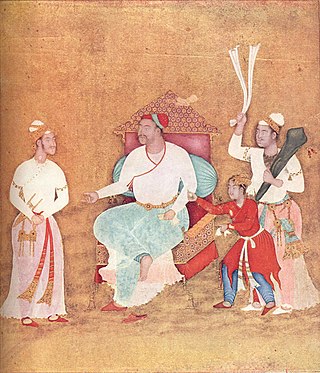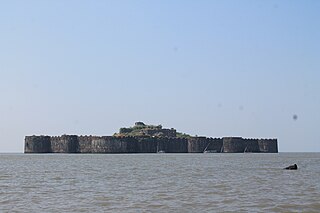
The Deccan sultanates is a historiographical term referring to five late medieval to early modern Indian kingdoms on the Deccan Plateau between the Krishna River and the Vindhya Range that were created from the disintegration of the Bahmani Sultanate and ruled by Muslim dynasties: namely Ahmadnagar, Berar, Bidar, Bijapur, and Golconda. The five sultanates owed their existence to the declaration of independence of Ahmadnagar in 1490, which was followed by Bijapur and Berar in the same year. Bidar became independent in c. 1492, and Golconda in 1512.

The Sultanate of Bijapur was an early modern kingdom in the western Deccan and South India, ruled by the Adil Shahi dynasty. Bijapur had been a taraf (province) of the Bahmani Kingdom prior to its independence in 1490 and before the kingdom's political decline in the last quarter of the 15th century. It was one of the Deccan sultanates, the collective name of the kingdom's five successor states. The Sultanate of Bijapur was one of the most powerful states on the Indian Subcontinent at its peak, second to the Mughal Empire which conquered it in 1686 under Aurangzeb.

Shahaji Bhonsale was a 17th century Indian military leader who served the Ahmadnagar Sultanate, the Bijapur Sultanate, and the Mughal Empire at various points in his career. As a member of the Bhonsle dynasty, Shahaji inherited the Pune and Supe jagirs (fiefs) from his father Maloji, who previously served the Ahmadnagar Sultanate. During the Mughal invasion of the Deccan, Shahaji joined the Mughal forces and served under Emperor Shah Jahan for a short period. After being deprived of his jagirs, he defected to the Bijapur Sultanate in 1632 and regained control over Pune and Supe. In 1638, he received the jagir of Bangalore after Bijapur's invasion of Kempe Gowda III's territories. Afterwards, he became the chief general of Bijapur and oversaw its expansion.

Malik Ambar was a military leader and statesman who served as the Peshwa of the Ahmadnagar Sultanate and its de facto ruler from 1600 until his death in 1626.
The Farooqi dynasty or the Farooq Shahi was the ruling dynasty of the Khandesh Sultanate from its inception in 1382 till its annexation by the Mughal emperor Akbar in 1601. The founder of the dynasty, Malik Ahmad participated in a rebellion against the Bahmani ruler Muhmmad Shah I in his early years. When he was compelled to flee from Deccan, he established in Thalner on the Tapti River. After receiving the grant of the fiefdoms of Thalner and Karanda from Firuz Shah Tughluq in 1370, he conquered the region around Thalner, which later became known as Khandesh. By 1382, he started ruling independently.

The Sultanate of Ahmednagar was a late medieval Indian Marathi kingdom located in the northwestern Deccan, between the sultanates of Gujarat and Bijapur, ruled by the Nizam Shahi dynasty. It was established when Malik Ahmed, the Bahmani governor of Junnar, after defeating the Bahmani army led by general Jhangir Khan on 28 May 1490, declared independence and established the Ahmadnagar Sultanate.
Burhan Nizam Shah I was ruler of the Ahmednagar Sultanate, in Central India. He ascended the throne on the death of his father Ahmad Nizam Shah I in 1508 or 1510 when he was seven years old. He died in 1553 and was succeeded by Hussain Nizam Shah I.

Daniyal Mirza was a prince of the Mughal Empire who served as the Viceroy of the Deccan. He was the third son of the emperor Akbar and the half-brother of the emperor Jahangir.

Burhan Nizam Shah II was the ruler of Ahmadnagar Sultanate in the Deccan. He was the second son of Hussain Nizam Shah I and Khunza Humayun Begum.

The Deccan sultanates were five early modern kingdoms, namely Bijapur, Golkonda, Ahmadnagar, Bidar, and Berar, which ruled the Deccan Plateau for part of the 15th, and the majority of the 16th–17th centuries. Their architecture was a regional variant of Indo-Islamic architecture, and influenced by the styles of the Delhi Sultanate and later Mughal architecture, but sometimes also influenced from Persia and Central Asia. Hindu temple architecture in the same areas had very different styles.

Hussain Nizam Shah I was the preeminent ruler of the Ahmadnagar Sultanate and the leading figure of the coalition of the Deccan Sultanates during the Battle of Talikota. Notably, Hussain Nizam Shah was responsible for taking prisoner and beheading Rama Raya of Vijayanagara after the Battle of Talikota.

Murtaza Nizam Shah II was the Sultan of Ahmadnagar from 1600 to 1610. His rule was dominated by the powerful regent Malik Ambar, under whom he was an effective puppet ruler.
The Battle of Bhatvadi was fought in 1624, near modern Bhatodi Pargaon village in Maharashtra, India. The Ahmadnagar army led by Malik Ambar defeated a combined Mughal-Bijapur force led by the Bijapuri general Mullah Muhammad Lari.

Khunza Humayun Begum also known as Kurja Sultana, Khanzada Humayun Sultana and Khunzah Humayun, was the regent of the Ahmadnagar Sultanate between 1565 and 1571, during the minority of her son sultan Murtaza Nizam Shah I.

Khwaja Sabir, Nasiri Khan or Khan-i-Dauran was an Indian Muslim viceroy of the Deccan and one of the Mughal emperor Shah Jahan’s leading sardars. He received the title "Khan Dauran" during the conquest of Daulatabad. He died in Lahore in 1645 from a knife wound from his own attendant, a Kashmiri Brahmin. He hald the rank of 7,000 horse.

The siege of Daulatabad (1633) was a conflict between the Mughal Empire and the Ahmadnagar Sultanate, wherein the fort-city of Daulatabad was besieged by a Mughal force for several months and successfully captured. The Bijapur Sultanate also participated in the conflict against the Mughals, sending a large army to the aid of the fort's garrison. The conflict took place after several Mughal victories securing other minor forts in Ahmadnagar control, but was distinguished by the political significance of Daulatabad to the Ahmadnagar Sultanate. This event marked Mughal victory in the ongoing war between the Mughals and the Ahmadnagar Sultanate; it ended the Nizam Shahi dynasty and concluded the Sultanate, marking another step in the Mughal advance over the Deccan region. The victory did not fully quell resistance to Mughal authority in the Western Deccan; a year later, Maratha commander Shahji Bhonsle attempted a bid for power using a puppet ruler of the Nizam Shahi house.

Fath Khan, also written as Fateh Khan, was a 17th-century political figure of the Ahmadnagar Sultanate, a historical principality spanning the Western Deccan region in the Indian subcontinent. He was the eldest son of Malik Ambar, the Peshwa of the Ahmadnagar Sultanate. He succeeded his father as the Sultanate's de facto ruler after the latter's death in 1626, and served as Peshwa until his imprisonment in 1633. His tenure, lasting less than a decade, spanned the eclipse days of the kingdom; it was characterised by internal strife and political pressure from the Mughal Empire. He played a key role in the kingdom's collapse by defecting to the Mughal Empire, and killed the ruler Burhan Nizam Shah III in the name of Mughal emperor Shah Jahan. His political career came to an end with the Siege of Daulatabad, after which he submitted to the Mughal emperor and became his pensioner.

The Vijayanagar Invasion of Bijapur was a coordinated campaign by a coalition of Ahmadnagar, Golkonda, and Vijayanagara, aimed at weakening the Bijapur Sultanate in the year 1543. Initiated by Burhan Nizam Shah I of Ahmadnagar, the alliance sought to capitalize on Ibrahim Adil Shah's vulnerabilities. Each ally targeted different regions Ahmadnagar attacked from the northeast, Golkonda from the east, and Vijayanagara advanced from the south under Rama Raya aiming to seize Raichur and the Doab.
Earlier Malik Ambar had ceded territories of Ahmednagar and Berar to Mughals however in 1617 A.D he broke the treaty with Mughals, In 1619 A.D he along with his Bargi troops commanded by Maloji laid a Siege to the Fort of Ahmednagar which he had lost to Mughals.
Hussain Nizam Shah III was the 12th Sultan of Ahmadnagar Sultanate under the regency of Fath Khan and Shahaji. It was during his reign the second phase of extinction of Ahmadnagar Sultanate began. He was imprisoned by Shah Jahan in the Gwalior Fort after Mahabat Khan's successful conquest of Dautlatabad. He was succeeded by Murtaza Nizam Shah III.
















